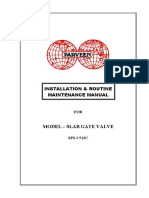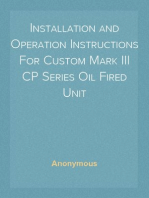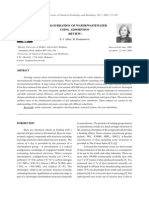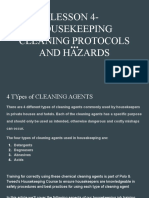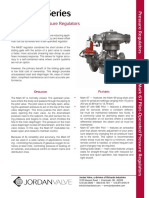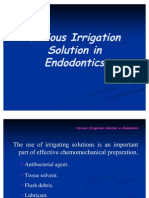Gate Valve Maintenance
Gate Valve Maintenance
Uploaded by
char_lynCopyright:
Available Formats
Gate Valve Maintenance
Gate Valve Maintenance
Uploaded by
char_lynCopyright
Available Formats
Share this document
Did you find this document useful?
Is this content inappropriate?
Copyright:
Available Formats
Gate Valve Maintenance
Gate Valve Maintenance
Uploaded by
char_lynCopyright:
Available Formats
VALVEWORKS USA
VALVEWORKS USA
Wholesale Distribution * Service *Support
Manufacturer of Quality Valve Components
Maintenance and Service Manual
API Gate Valves
VALVEWORKS USA
INTRODUCTION
In appreciation to you for
purchasing our product, we have
prepared this Maintenance Manual
to assist you in the installation,
operation and maintenance of the
VALVEWORKS USA API Gate
Valve.
WE encourage you to follow
recommendations in this manual to
attain the best possible service
from our product, which is
Designed and proven to offer the
service one can expect of a quality
product.
Occasionally you may need to
contact a representative for more
specific information pertaining to
a special problem. Should this
occur, you should contact
VALVEWORKS USA
1841 BARTON DRIVE
SHREVEPORT, LOUISIANA USA 71107
PHONE: 318-425-0266 FAX# 318-425-0934
TOLL FREE: 888-425-0266
EMAIL: SALES@VALVEWORKSUSA.COM
WEBSITE: WWW.VALVEWORKSUSA.COM
IDENTIFICATION
All VALVEWORKS USA Production Gate Valves are manufactured in full accordance with API
Standard 6A specifications, including:
SIZE WORKING PRESSURE MODEL
2", 2 1/2", 3", 4"
2,000 psi
3,000 psi
5,000 psi
M
1 13/16", 2 1/16",
2 916", 3 1/16",
4 1/16"
10,000 psi
15,000 psi
M1
The gate of the MODEL M & M1
Valve consists of two pieces (gate
and segment) acting one against
the other by means of a dual
wedge when the valve is either
fully closed or fully opened.
The expansion effect of the wedge
against the seats, through the
Parallel faces of the gate, provides
a strong and positive seal against
pulsations and vibrations created
by flow conditions.
2000, 3000 and 5000 psi W.P.
valves are non-rising stem type;
valves of 10,000 and 15,000 psi
W.P. are rising stem type and utilize
two stems to balance and equalize the
pressures against the valve body,
effectively reducing operating torques.
1. Fully open the valve before
installing or shipping. The sealing
area of the gates in the full open
position are protected by the body
and are less likely to be damaged.
2. Do not remove the
molybdenum disulfide coating
from internal parts. This coating
serves as a lubricant and corrosion
inhibitor.
3. To hydrostatically test the
valve body to full API test
pressure, the valve must be in a
partially open position. When
testing the valve in the closed
position (seat test) do not exceed
the working pressure stamped on
the valve identification plate.
INSTALLATION AND OPERATING PROCEDURES
4. During storage always leave
the valve in the fully opened or
fully closed position. This will
tightly wedge the gate and
segment against the seats and
prevent damage to the sealing area
of both the gate and seats.
5. Always remove the valve from
service before work is performed
on the stem bearings.
6. When lubricating the body do
not exceed the maximum API
working pressure stamped on the
identification plate.
7. The valve should be fully
closed or fully opened during
lubrication of the body or seats.
8. Seat lubrication pressures
should not exceed the maximum
allowable API test pressure. The
expanding gate design of
VALVEWORKS USA Valves
provides a tight mechanical
positive seal; however to properly
effect this seal, the valve must be
fully opened or fully closed in
order to wedge the gate and
segment against the seats. Do not
back off the handwheel.
This method of operation will
prevent damage to the sealing
surfaces of the gate and seats, and
will increase the life of the valve.
VALVEWORKS USA
The Model M & M1 Gate Valve is
a nonlubricated valve, in that it
does not require the injection of
lubricants or sealants to effectively
seal. To prevent corrosion and
excessive wear a normal amount
of lubrication is recommended to
extend the life and serviceability
of the valve.
MAINTENANCE EQUIPMENT
To perform normal maintenance
and lubrication, the following
tools are recommended:
1) Grease gun with adapter and
copling (Fig. 1).
2) Safety pressure releasing tool
(Fig. 2).
Valveworks USA API Gate
Valves, 2000 psi W.P. 10,000 psi
W.P. are supplied with 1/2" NPT
body fitting connections. Body
fittings on 15,000 psi W.P. valves
are 1/ 1/8" 12 UN. Threads.
Valveworks USA API valves are
equipped with alemite hyhdraulic
type 1/8" NPT bonnet grease
fittings. Stem bearing lubrication
is accomplished through this
fitting using a standard type grease
gun (Fig. 3).
Any good grade No. 3 grease is
recommended for this lubrication.
Stem bearing normally do not
require great amounts of grease. If
overlubrication should occur,
excess grease will flow around the
stem to the atmosphere.
CAUTION: If bearings should
need to be changed, the valve
must be removed from service.
STEM BEARING LUBRICATION
Fig. 3 - Lubrication Stem Bearings
Fig. 1 - Grease Gun Fig. 2 - Safety Pressure
Releasing Tool
VALVEWORKS USA
BODY LUBRICATION
Valves may require body lubrication if
they become hard to operate or when they
are used in corrosive service conditions.
For this purpose, each valve has two
safety ball check fittings located at the
bottom and top of the body of the valve.
Generally any good grade 3, 4 or 5 grease
is recommended for body lubrication, but
caution is to be taken not to use a grease
soluble by the product flowing through
the valve.
Approximately one pound of grease per
inch of valve bore size is sufficient to
provide adequate lubrication.
Place the valve in the fully opened or fully
closed position. Remove the safety caps
from both safety ball check fittings (Fig.
4) and install the pressure release tool
(Fig. 2) on either fitting (Fig. 5) Install the
grease gun fitting (with gauge) (Fig. 1) on
the other fitting (Fig. 6).
A 1/2" NPT 10,000 psi W.P. needle valve
may be attached to the outlet of the
pressure release tool as a safety measure,
should the ball check not hold pressure.
Open 1/2" needle valve, rotate handle of
pressure release tool clockwise until main
stem makes contact with the ball check
(Figs. 12 and 13); unseat same to release
existing body pressure.
If the body pressure does not bleed down
completely, the volume of the pressure
released can be controlled with the
pressure release tool. Continue injecting
grease into the body through the other
grease fitting. After lubrication, reinstall
the two safety caps and operate the valve
several times and return to desired
position.
CAUTION: During pressurized valve
body lubrication, pressure applied to
the valve body with the grease gun
must not exceed the maximum working
pressure of the valve being lubricated.
Fig. 5 - Installing Pressure Releasing Tool
Fig. 4 - Removing Safety Cap from Body Drain Fitting
Fig.6 - Grease Gin Fitting
Attached to Body
VALVEWORKS USA
INTERNAL SEAT LUBRICATION
The Model M1 Balanced Stem API Gate
Valves, 10,000 psi W.P. and up are
designed to allow internal seat lubrication.
This means of lubrication is provided as
an emergency measure to obtain a seal
when seats and gate become scored or
scratched from foreign matter in the
valve, particularly when it has been in the
closed position for long periods of time.
For seats lubrication 102 lubricant is
recommended.
During seat lubrication the valve must be
in the fully opened or fully closed
position. Remove the safety caps from the
two safety ball check grease fittings
located on the centerline of the valve
bore; connect the grease gun (Fig. 1) to
the grease fittings and proceed with
lubrication of seats (Fig. 7).
CAUTION: When lubricating the seats,
do not exceed the maximum working
pressure of the valve. Once the
lubricating operation has been
completed, operate the valve several
times allowing the grease to be
distributed over the face of the seats
and gate.
STEM PACKING
Plastic packing is added to the stuffing
box through the plastic injection fitting on
the valve bonnet to further energize the
packing around the stem, shutting off
package leakage.
There are different types of plastic
packing depending on service and
temperature. Packing is available in 3/8"
X 1" (9.5 mm X 25.4 mm) sticks to be
injected through the packing fitting on the
valve bonnet (Fig. 8).
Fig. 7 - Seat Lubrication
Fig. 8 - Bonnet Packing Fitting.
Note Bleeder Hole
VALVEWORKS USA
Packing fittings used on Model M & M1
API Valves (Fig. 9) are 1/2" (12.7 mm) 14
NPT standard thread connection. This
fitting is equipped with a safety ball check
which allows the insertion of plastic
packing without special adapters or tools.
Stick packing can be added through the
packing fitting with the valve under
pressure. The valve may be installed in
any position.
PROCEDURE
1) Run the 3/4" hex head screw all the
way into the fitting and then back out
slowly; observe the bleeder hold (Figs. 8
and 9) in the packing fitting. If no
pressure or plastic packing is observed
flowing out through this hole, this would
indicate that the ball check has seated. At
this point, the packing screw can be
removed (Fig 10).
2) Apply one stick at a time (Fig. 11) until
the leak has stopped. Apply only as much
packing as needed to stop the leak.
Excessive packing pressure will cause the
stem to bind and will make operation of
the valve difficult.
NOTE: On balanced stem valves 10,000
psi W.P. and up, both stems should be
inspected and packed when required.
Fig. 9 - Packing Fitting
Fig. 10 - Removing Packing Fitting Screw with Wrench
Fig. 11 - Inserting Stick Packing
VALVEWORKS USA
PROCEDURE
Most products contain a certain
amount of water, line scale, sediment
and other foreign matter which tend to
accumulate in the valve body. A
regular draining program will increase
the life of a valve against damage
caused by:
1) Water freezing in the body cavity,
causing damage to the body.
2) An accumulation of foreign matter
in the lower part of the body, which
could prevent the valve from fully
closing.
resulting in a throttling action which
may cause inefficient sealing.
3) Foreign matter trapped in the body
may become lodged between the
sealing surfaces of the gate and seats,
resulting in scored or damaged
sealed.
4) Venting a Model M & M1 valve,
is a positive method of checking the
sealing ability of the gate and seats.
If the body vents down to zero
pressure with the valve in fully closed
position, this is definite indication that
sealing surfaces are in good condition.
PROCEDURE TO VENT OR DRAIN
1. Place the valve gate in a fully opened or
fully closed position.
2. Remove the safety cap from either body
grease fitting and attach the pressure
release tool (figs. 2, 4 and 5).
CAUTION: Remove the safety cap
slowly to allow the ball check to
sufficiently seal, to avoid uncontrolled
venting (Fig. 12). Should the ball check
fail to seal properly, pressure will
continue to blow through the safety cap
orifices. You should then retighten the
safety cap screw and vent through the
other body grease fitting. Once the body
pressure is bled to zero you should then
attempt to repair the leaking ball check.
3. Screw the stem of the releasing tool into
the fitting forcing the ball check off its seat.
The valve will vent and drain once the ball
check is unseated (Fig. 13).
A program of regular draining and body
venting is the most positive way to prevent
problems caused by foreign matter in the
valve. However, if a regular draining
program cannot be followed, it is
recommended that valves be drained after
the following operations:
1) After a well has come in and has been
cleaned up.
2) After a mudding operation.
3)After a cementing operation.
4) Anytime the valve seems hard to operate
by hand and will not fully open or close by
the required number of handwheel turns.
5) When the valve is hard to operate
from the fully open or fully closed
position because it is "pressure locked"
or "Iced-up".
"Pressure locked" is a condition that may
exist with any dual seat expanding type
gate valve when body pressure greatly
exceeds line pressure. It occurs only in
fully closed position and is a positive
indication that sealing surfaces are in
good condition.
Fig. 12 - Body Grease Fitting
Fig. 13 - Safety Releasing Tool Attached to Fitting
Safety Releasing Tool Stem
before displacing Ball Check.
There is no flow.
Safety Releasing Tool Stem
after displacing Ball Check.
Flow is established.
VALVEWORKS USA
"Iced-up" is a condition caused by a
restriction in the flow or a differential
in the pressure of gas flow at high
pressure, which produces extremely
low temperatures. These restrictions
or differentials in pressure may be
caused by throttling through a valve,
by leakage of a closed valve or by
Leakage through the stem packing.
Valves in service on gas containing
hydrates or in fresh water service,
exposed to low external temperatures
may also "iced-up". In this case it is
advisable to inject alcohol or glycol
into the valve body through the drain
fitting to combat these conditions.
The same procedures are used for
injecting alcohol or glycol as are used
for valve body lubrication. Do not
operate the valve immediately after
injecting as these fluids should be
retained in the body to perform the
antifreeze effect.
IDENTIFICATION PLATE
Identification plates are attached to all
Valveworks USA API Production Gate
Valves and they are located on the bonnet
of each valve and warrants that all products
are manufactured to design and quality
control specifications of industry standards.
The information listed on the identification
plate should be referred to when ordering
replacement parts (Fig. 14).
Fig. 14 - Identification Plate on Valve
You might also like
- Townsend - Kb2-Type 81 RepairDocument39 pagesTownsend - Kb2-Type 81 Repairchar_lyn100% (1)
- Townsend - Kb2-Type 81 RepairDocument39 pagesTownsend - Kb2-Type 81 Repairchar_lyn100% (1)
- Townsend - Kb2-Type 81 RepairDocument39 pagesTownsend - Kb2-Type 81 Repairchar_lyn100% (1)
- Crosby-Pentair JOS-E Series DatasheetDocument14 pagesCrosby-Pentair JOS-E Series Datasheetjromero_rpg100% (1)
- ANSON Inline Check ValveDocument4 pagesANSON Inline Check ValveNamikaze Minato0% (1)
- McEvoy Gate ValvesDocument11 pagesMcEvoy Gate ValvesWeniton Oliveira0% (1)
- Cameron 4 Way Valve (Prover Unit)Document3 pagesCameron 4 Way Valve (Prover Unit)Yasser Mahmoud100% (1)
- Axelson 6 PDFDocument12 pagesAxelson 6 PDFAnggi SujiwoNo ratings yet
- Wom ValvesDocument11 pagesWom ValvesRio IndokniveziaNo ratings yet
- Unit Operasi & Proses IPAL (SPS)Document54 pagesUnit Operasi & Proses IPAL (SPS)Angga Budi KusumaNo ratings yet
- EGV ManualDocument15 pagesEGV ManualT.MuthuvijayapandiNo ratings yet
- Valvework Usa. Model M MSGDocument7 pagesValvework Usa. Model M MSGLuis Enrique RicoNo ratings yet
- API Gate Valve - WKM Maintenance ManualDocument8 pagesAPI Gate Valve - WKM Maintenance ManualsambhajiNo ratings yet
- Globe Valve General Installation Operation & Maintenance ManualDocument5 pagesGlobe Valve General Installation Operation & Maintenance ManualViba Fluid ControlNo ratings yet
- Gate Valve Installation Operation & Maintenance ManualDocument5 pagesGate Valve Installation Operation & Maintenance ManualViba Fluid ControlNo ratings yet
- Choke Valve MSPDocument26 pagesChoke Valve MSPabbas1368No ratings yet
- CXS Tubing HangerDocument10 pagesCXS Tubing Hangerrake1981No ratings yet
- Gate Valve Troubleshoot-2Document33 pagesGate Valve Troubleshoot-2Trushar GhosalkarNo ratings yet
- Scope of Work - in Situ Repair of Butterfly ValvesDocument1 pageScope of Work - in Situ Repair of Butterfly ValvesVamshi EFCO IndiaNo ratings yet
- Operational and Maintenance Manual PDFDocument19 pagesOperational and Maintenance Manual PDFYuda100% (1)
- Surs PDFDocument27 pagesSurs PDFsaeed65No ratings yet
- Poppet Relief ValveDocument8 pagesPoppet Relief Valvenghiemta18No ratings yet
- 350q-5 Operation ManualDocument97 pages350q-5 Operation ManualCesar Mora100% (2)
- G.V. Manual (FC Type)Document20 pagesG.V. Manual (FC Type)sambhajiNo ratings yet
- Nitrogen MsdsDocument6 pagesNitrogen MsdssalcabesNo ratings yet
- Mud Gate ValveDocument16 pagesMud Gate ValvesudhisnairNo ratings yet
- KF Series Ball Valve PDFDocument20 pagesKF Series Ball Valve PDFbloggerparthiNo ratings yet
- F 401 IeDocument12 pagesF 401 IeMatt EbrahimiNo ratings yet
- Seat Tightness of Pressure Relief Valves Api Standard 527 Fourth Edition November 2014 PDF FreeDocument15 pagesSeat Tightness of Pressure Relief Valves Api Standard 527 Fourth Edition November 2014 PDF FreestudentmgmNo ratings yet
- FMC Flowline Product CatalogDocument80 pagesFMC Flowline Product CatalogRodrigo França100% (2)
- 8560 Edisc Butterfly Control ValveDocument32 pages8560 Edisc Butterfly Control ValveZakNo ratings yet
- Operation & Maintenance Manual Model Aph Hydraulic ActuatorDocument69 pagesOperation & Maintenance Manual Model Aph Hydraulic ActuatorSasan AbbasiNo ratings yet
- Ringo Gate Globe Check ValvesDocument28 pagesRingo Gate Globe Check ValvesRIGOBERTO PONCENo ratings yet
- Low Torc ValveDocument4 pagesLow Torc Valvejinyuan74100% (2)
- ActuationDocument12 pagesActuationSrimp sasaNo ratings yet
- Api 623 Cast Steel Globe Valve: Installation, Operation and Maintenance ManualDocument20 pagesApi 623 Cast Steel Globe Valve: Installation, Operation and Maintenance ManualFahmi HaidiNo ratings yet
- Triplex Pump ManualDocument11 pagesTriplex Pump ManualDustin WhiteNo ratings yet
- 4 - B - SPM Plugvalves - Technical InfoDocument8 pages4 - B - SPM Plugvalves - Technical Infokaabach80No ratings yet
- ANSI Flange Bolt & Stud ChartDocument2 pagesANSI Flange Bolt & Stud Chartkh88hmiNo ratings yet
- H05122020-003-GA VR Lubricator PBMO 15ksi Flanged Version W 48in Stroke Rev ADocument1 pageH05122020-003-GA VR Lubricator PBMO 15ksi Flanged Version W 48in Stroke Rev Aseyidkhaled kadriNo ratings yet
- TLDD-2016-2AAG-D06-0001 - Code 2Document5 pagesTLDD-2016-2AAG-D06-0001 - Code 2Cao Huu Tung100% (1)
- Pressure Seal Valves-GateDocument24 pagesPressure Seal Valves-GateHieu NguyenNo ratings yet
- BPV Specification and Drawings PDFDocument4 pagesBPV Specification and Drawings PDFParag PadoleNo ratings yet
- ANSON Pressure Relief Valve Operating, Maintenance & Setting ManualDocument8 pagesANSON Pressure Relief Valve Operating, Maintenance & Setting ManualChirasak PaksasornNo ratings yet
- SSV Control System SHUT DOWN VALVEDocument12 pagesSSV Control System SHUT DOWN VALVEglobal3tNo ratings yet
- Tech Manual 1222B: Booster Cylinder Assembly EH34-BC03Document21 pagesTech Manual 1222B: Booster Cylinder Assembly EH34-BC03jose perozoNo ratings yet
- Section 6 PDFDocument7 pagesSection 6 PDFFernanda Medeiros CarvalhoNo ratings yet
- Gate Valve API 6ADocument4 pagesGate Valve API 6ARicardo Paz SoldanNo ratings yet
- Chart RecordersDocument4 pagesChart RecordersRichard More Leon100% (1)
- General Technical Specifications For CS & SS Pipes and Pipe FittingsDocument10 pagesGeneral Technical Specifications For CS & SS Pipes and Pipe FittingsrajaNo ratings yet
- 001 - Plug Valves InspectionDocument8 pages001 - Plug Valves InspectionahmedNo ratings yet
- Testing StandardDocument7 pagesTesting StandardDiego Fernando Pedroza UribeNo ratings yet
- Cameron H2 Part NumbersDocument1 pageCameron H2 Part NumbersDavid OrtegaNo ratings yet
- Acme Thread 29 Formulas Depth 0.5/N+0.01Document6 pagesAcme Thread 29 Formulas Depth 0.5/N+0.01Dhanraj VasanthNo ratings yet
- Uztel OrizontalDocument5 pagesUztel OrizontalDorin RaduNo ratings yet
- C47 Series IOMDocument8 pagesC47 Series IOMKannan KrisNo ratings yet
- Handbook Sealweld Valvulas de ProcesoDocument92 pagesHandbook Sealweld Valvulas de Procesofelipe castellanosNo ratings yet
- Air Operated Hydraulic Presses Instuction and Parts List For Models 6-225 6-425 6-250 6-450 6-275 6-475 6-650 6-850Document11 pagesAir Operated Hydraulic Presses Instuction and Parts List For Models 6-225 6-425 6-250 6-450 6-275 6-475 6-650 6-850grantNo ratings yet
- TBV Series 21 20 Cryogenic Flanged Ball ValveDocument5 pagesTBV Series 21 20 Cryogenic Flanged Ball ValveJosip PobranNo ratings yet
- Iom Gen Truseal 1Document16 pagesIom Gen Truseal 1tsuoscaradrian100% (1)
- Operation and Service Manual For Model M & MSG: Alveworks USADocument26 pagesOperation and Service Manual For Model M & MSG: Alveworks USAAshok SureshNo ratings yet
- Array Gate Valve Item 1Document11 pagesArray Gate Valve Item 1sitaNo ratings yet
- Installation and Operation Instructions For Custom Mark III CP Series Oil Fired UnitFrom EverandInstallation and Operation Instructions For Custom Mark III CP Series Oil Fired UnitNo ratings yet
- Types of Valves in Piping: Types of Valves - Tables to estimate man hours of assemblyFrom EverandTypes of Valves in Piping: Types of Valves - Tables to estimate man hours of assemblyNo ratings yet
- ApplicationGuide Maximator ProDocument4 pagesApplicationGuide Maximator Prochar_lyn100% (1)
- API HoistingDocument5 pagesAPI Hoistingchar_lynNo ratings yet
- Demco Gate ValveDocument1 pageDemco Gate Valvechar_lynNo ratings yet
- RINNER Motor 57 SeriesDocument2 pagesRINNER Motor 57 Serieschar_lynNo ratings yet
- Oil Country 45000Document70 pagesOil Country 45000char_lyn100% (2)
- Owner'S Manual: Installation, Operation and Maintenance Instructions For Rotzler Titan Planetary Hydraulic WinchesDocument44 pagesOwner'S Manual: Installation, Operation and Maintenance Instructions For Rotzler Titan Planetary Hydraulic Wincheschar_lyn100% (1)
- Product CatalogueDocument44 pagesProduct CatalogueNitin AggarwalNo ratings yet
- Townsend - Kb2-Type 84 RepairDocument35 pagesTownsend - Kb2-Type 84 Repairchar_lyn100% (1)
- Tubular Product Manual Oct G Casing PropertiesDocument14 pagesTubular Product Manual Oct G Casing Propertieschar_lynNo ratings yet
- Maxx ControlDocument4 pagesMaxx Controlchar_lynNo ratings yet
- Service Manual SectionDocument30 pagesService Manual SectionJKLUIS_593% (14)
- Panchvidh Kashay KalpanaDocument53 pagesPanchvidh Kashay KalpanashreerangayurvedNo ratings yet
- Enzyme 20pagesDocument20 pagesEnzyme 20pagesEddie Optin100% (2)
- Introduction To Chemical & Pharma TechnologyDocument42 pagesIntroduction To Chemical & Pharma Technologysswoo3868No ratings yet
- Cl10 Chem Notes Carbon and Its CompoundsDocument18 pagesCl10 Chem Notes Carbon and Its CompoundsMaryamNo ratings yet
- Lec 1Document38 pagesLec 1Pavithra SivanathanNo ratings yet
- Forensic 3 QuestionerDocument1 pageForensic 3 QuestionerKenneth AlatanNo ratings yet
- Antifreeze Concentrate SDSDocument9 pagesAntifreeze Concentrate SDSDaniel DaiaNo ratings yet
- 2.1 Energetics TestDocument8 pages2.1 Energetics TestLordie DlaNo ratings yet
- Ag. Power, Machinery, and Allied Subject - Part 5Document99 pagesAg. Power, Machinery, and Allied Subject - Part 5Vonne Bryan IhalasNo ratings yet
- Decolourisation of Water-Wastewater Using Adsorption (Review)Document18 pagesDecolourisation of Water-Wastewater Using Adsorption (Review)Altus Schoeman100% (1)
- Wifpl Qap 2019-20-015 Rev 00 Mdns 40ni6cr4mo3 SignedDocument3 pagesWifpl Qap 2019-20-015 Rev 00 Mdns 40ni6cr4mo3 SignedDeipak HoleNo ratings yet
- RinciDocument6 pagesRinciSabaruddin HarahapNo ratings yet
- 8ch0 Chemistry Paper1 QPDocument28 pages8ch0 Chemistry Paper1 QPkabirmuhayminNo ratings yet
- Types of Chemical ReactionsDocument7 pagesTypes of Chemical ReactionsNabil AbdullahNo ratings yet
- HK1 - Housekeeping Cleaning Protocols and HazardsDocument42 pagesHK1 - Housekeeping Cleaning Protocols and HazardsAngel Lynne de VeraNo ratings yet
- X DULUX Timbertone A398-Line ENDocument8 pagesX DULUX Timbertone A398-Line ENAzuan MABKNo ratings yet
- Catálogo de Bujias BoschDocument4 pagesCatálogo de Bujias BoschRodrigo Vidal EscrivàNo ratings yet
- 35 Days Plan For JEE ADV 2023Document1 page35 Days Plan For JEE ADV 2023gggggNo ratings yet
- MarkDocument4 pagesMarknatalNo ratings yet
- Central Pollution Control Board: Cems - The Ultimate Tool For Emission RegulationDocument46 pagesCentral Pollution Control Board: Cems - The Ultimate Tool For Emission RegulationRaden MasNo ratings yet
- Biochemistry of NeurotransmittersDocument7 pagesBiochemistry of NeurotransmittersHyphophysis 2015No ratings yet
- OCR A Biology 2019 Mark SchemeDocument27 pagesOCR A Biology 2019 Mark SchemeHasan ShahzadNo ratings yet
- Lec 42Document24 pagesLec 42Prabuddha BhattacharyaNo ratings yet
- Test Method: Renault Automobiles Standardisation DQSC - S / Department 00621 Section Normes Et Cahiers Des ChargesDocument9 pagesTest Method: Renault Automobiles Standardisation DQSC - S / Department 00621 Section Normes Et Cahiers Des Chargesclaudio5475No ratings yet
- Untitled DocumentDocument6 pagesUntitled Documentpgnavarro4133pamNo ratings yet
- Micromeretics and Powder RheologyDocument50 pagesMicromeretics and Powder Rheologydharmendra kumar100% (1)
- Us 2599553Document5 pagesUs 2599553mgamal1080No ratings yet
- Schalldaempfer SD22 Bed GBDocument5 pagesSchalldaempfer SD22 Bed GBDjWagner007No ratings yet
- Irrigation in EndodonticsDocument94 pagesIrrigation in EndodonticsRajsandeep SinghNo ratings yet





















